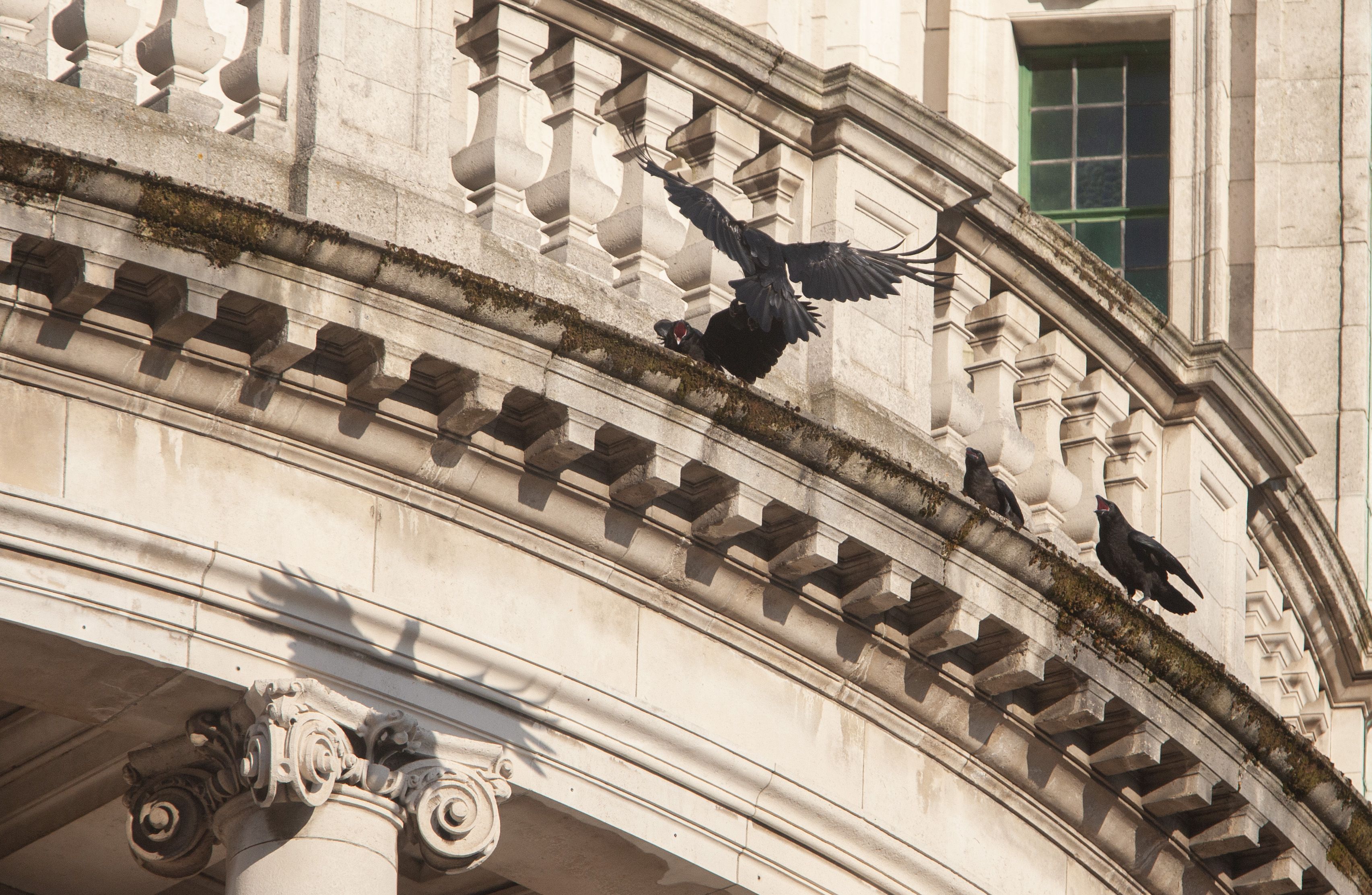IT’S something Dúlra never even thought possible. That a legendary bird of our most extreme habitats – of mountaintops and windswept coastal headlands – could be living and breeding among us in Belfast. And not just any part of Belfast, but, incredibly, on the very citadel of the city, the building at its heart that represents us all.
Yes, ravens are nesting on Belfast City Hall.
It’s a feat so remarkable that you’d have to provide photographic evidence to be believed – and that’s exactly what Andersonstown News photographer Thomas McMullan got this week.
His pictures show the giant, graceful birds flying around that famous Dome as tourists and workers soak up the sun on the grass below.
People in the city centre are so busy that they don’t often take notice of nature; most of the birds here are pigeons and gulls, starlings and common crows. When Dúlra visited this week, the masses of people enjoying the grounds of City Hall didn’t seem to notice the five big black birds on the roof: two adults and their three offspring.
The nest that they had just left was a large platform of twigs behind a gargoyle on one corner, directly in line with the new Mary Ann McCracken statue. Ravens are early nesters, they lay their eggs in freezing February and the parents, who mate for life, are extremely attentive. The young hatch after three weeks and the chicks are fed for more than a month before they are big enough to leave. But even after they leave the nest, they are no more able to fend for themselves than primary school kids.
The City Hall family of ravens will stay together for an incredible six months, all the way to the start of winter. They won’t always stick around the City Hall itself, of course, but they’ll likely stay in their new home – the city centre – during all that time.
Young ravens are among the most playful of bird species, even sliding on snowbanks purely for fun and playing catch-me-if-you-can with foxes and dogs. They are one of only a few wild animals who make their own toys, breaking off twigs to play with.
This week Dúlra must have seemed a little odd when sat down among the sun-worshippers on the City Hall lawn. While everyone else scrolled on their phones or chatted to friends, Dúlra spent the whole time gazing skywards, his face wide with wonder. He could hardly believe that he was watching a family of ravens – that rare mountain bird – on Belfast City Hall.
Many people there would have dismissed them as just another crow, but once you stop to look at them, the difference is clear. Ravens are enormous crows, much bigger than the common ones we see everywhere. And they are somehow blacker, like they’ve been dipped in ink.
They are a famous Irish bird of the wilderness, whose isolation, appearance and behaviour have led them to be wrapped up in centuries of folklore. Dúlra, like most birders, knows where to go to see one of Ireland’s 3,500 pairs: either the summit of Divis Mountain or Napoleon’s Nose.
It’s on these desolate outcrops that the giant jet-black bird of legend reigns supreme, its deep frog-like croak echoing over the land below. But this year something changed. A pair of ravens somehow ventured into the city and liked what they saw. Ravens have one of the widest palates of any bird, eating everything from berries to other young birds, and they certainly won’t turn up their beak to some lunchtime leftovers on the City Hall lawn. They are quick learners, with one of the biggest brains of any bird. One scientist showed that they are one of only four animals who have mastered linguistic displacement, in that they can communicate about things that happened in a different place or time (the others are us, bees and ants). He discovered that a bird who found a carcass could tell other roosting ravens about it and they would all go together the next day to enjoy the feast! At just four months old, it’s estimated that ravens have the same intelligence as adult chimps.
Ravens also know how to put on a show. One of nature’s finest sights is a mating pair’s aerobatic displays, where they fly in loops and interlock talons with each other in mid-air. Imagine being able to see that as you eat a sandwich in the grounds of Belfast City Hall!
Irish folklore is rich with references to the fiach dubh, and more often than not, it was as a portent of death. When you see a statue of Cú Chulainn, there will always be a raven on his shoulder: only when it landed were his enemies brave enough to approach him as they could be sure he was dead.
Perhaps the most famous ravens in the world live in the Tower of London. These are bred in captivity and legend has it that their numbers can never fall below six. If they are lost or fly away, it’s said that ‘the Crown will fall and Britain with it.” To make sure that never happens, their wings are clipped!
These birds are treated like royalty, but the fact they are to all accounts living in captivity for the entertainment of tourists invites analogies with the royal family itself.
Belfast’s City Hall’s new ravens could also become a tourist attraction. It’s even better that they arrived here to breed of their own accord, unlike those in the Tower of London.
Ravens enjoy long lives – 20 years or more – so this first generation of Belfast ravens could be the start of something special.
• If you’ve seen or photographed anything interesting, or have any nature questions, you can text Dúlra on 07801 414804.







